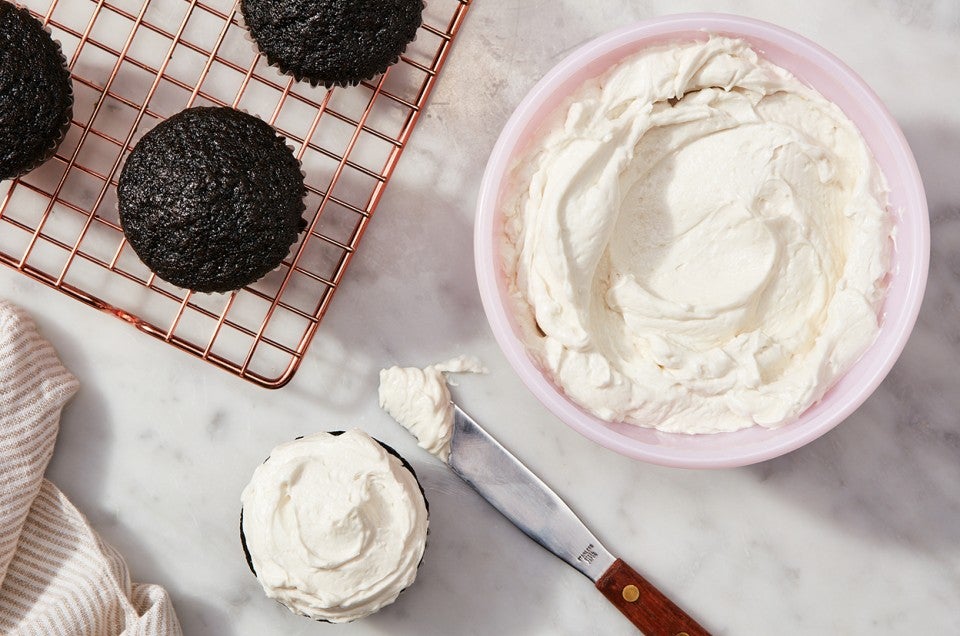How to make buttercream without the butter
This vegan Swiss buttercream is as smooth, spreadable, and sweet as its classic counterpart.


When Florida-based cake baker Dawn Konofaos wrote a blog post on painting cake with buttercream last year, it was packed full of inspiring decorating techniques and beautiful cake photos.
But tucked behind all that artful creativity was an ingenious baking tip that went far beyond making cakes look good: how to make vegan Swiss buttercream.
Dawn is an exclusively vegan baker, and she drew on her extensive knowledge to make a plant-based, dairy-free version of our classic Swiss Buttercream recipe for her blog post. Here at King Arthur, we were already looking to add more vegan and plant-based recipes to our site, and when we saw Dawn’s tip, we knew she’d shared the perfect template to develop an entirely new vegan Swiss buttercream recipe. One that would be something of an oxymoron: a buttercream made without any butter at all.

Classic Swiss buttercream is made by heating sugar, egg whites, and salt, then beating to make a stiff meringue. Softened butter is then added a few tablespoons at a time, emulsifying with the meringue to form a smooth, silky frosting.
The first challenge to veganizing this traditional recipe is finding a plant-based substitute for the egg whites, and for that task, there’s only one natural solution: aquafaba. The liquid left over from canned chickpeas, this viscous, protein-packed substance whips into stiff peaks just like meringue, making it a one-of-a-kind replacement for the eggs in this buttercream. (For more details, see our post, A guide to aquafaba.)
The next step is the butter. Thankfully, plant-based butter has become widely available in supermarkets, with brands like Earth Balance and Miyoko’s providing products that make vegan baking a lot easier. Swapping dairy-based butter for a plant-based brand is an easy solution. (For more on baking with plant-based butter, see our post, The baking trials: butter vs. vegan butter.)

Switching vegan ingredients for their conventional counterparts is one thing; developing a fail-proof recipe that works in everybody’s kitchen is another.
Using Dawn’s formula as a guide, King Arthur recipe tester Lydia set out to test a final recipe. She was a little nervous at first, particularly about the use of aquafaba. “I tend to find anything with aquafaba savory in general. Even meringues have a nuttiness to them,” she says. But when she (literally) whipped up a batch, she was pleasantly surprised. “This frosting was very smooth, and it tasted dessert-like, not savory.”
Over the course of testing, Lydia found the brand of certain ingredients can make a subtle difference in the final results. Not all vegan butter brands are the same, and the aquafaba from various chickpea brands can vary as well. For the aquafaba, she preferred Progresso, in part because they offer 19-ounce cans (which provide enough aquafaba for the full recipe). Whichever brand you choose, be sure to purchase a 19-ounce can of chickpeas if you can find it. Lydia also notes that if your aquafaba has bits of chickpea in it, you should strain it to remove any particles.
For the butter, Lydia prefers Miyoko’s, which she says worked “like a dream.” In her opinion, it had better flavor than Earth Balance butter sticks (which she said leaned saltier and more savory), yielded a fluffier texture, and the frosting held up better during piping.

Lydia gleaned a few additional insights for ultimate vegan buttercream success. She says superfine sugar (also known as castor sugar) works better than typical granulated sugar, as the larger sugar granules don’t dissolve as easily into the meringue. She recommends using a product like Baker's Special Sugar if you can.
The finished frosting is “really silky, but very soft,” according to Lydia. Once it’s done it won’t be stiff enough to frost a cake right away, so she recommends chilling it for around 25 to 30 minutes to firm up, then rewhipping before using it. That said, this frosting can be made a couple of days in advance and stored in the fridge; to use, simply pull it out and rewhip it until smooth and spreadable.
Once you do, you’ll have a sweet, silky frosting that looks and tastes just as good as any dairy-based version – an unconventional buttercream without any butter at all.
Looking to pair this Vegan Swiss Buttercream with a vegan cake? See our recipes for Vanilla Cake Pan Cake, Dark Chocolate Cake, and Vegan Chocolate Cupcakes.
Cover photo by Rick Holbrook.

